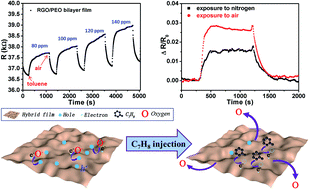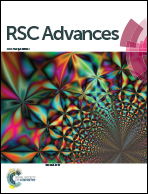Reduced graphene oxide–polyethylene oxide hybrid films for toluene sensing at room temperature†
Abstract
A reduced graphene oxide (RGO)–polyethylene oxide (PEO) hybrid film was constructed with composite and bilayer film structures for effective ambient toluene detection. The morphology and chemical properties of the fabricated RGO–PEO hybrid materials were characterized by SEM, and Raman and FTIR spectroscopies, respectively. Sensitive properties of real-time response, sensitivity, repeatability and selectivity to toluene vapor were studied as well at room temperature. The experimental data show that the gas sensors based on composite film have a higher sensitivity than the ones based on bilayer film and pure RGO film at toluene concentrations from 80 ppm to 140 ppm. In addition, the effect of PEO volume fraction and humidity on the sensing performance was also studied. The sensor with a PEO volume fraction of 50% has a better sensitivity and faster response/recovery than others. With respect to selectivity, the gas response of the prepared sensors to toluene was at least 2-fold higher than those to other vapor species, including acetone, ethanol, hydrogen, water and formaldehyde. Furthermore, the sensing mechanism of the fabricated sensors was investigated by comparing the device performance in the presence of dry air or nitrogen as carrier gas.


 Please wait while we load your content...
Please wait while we load your content...